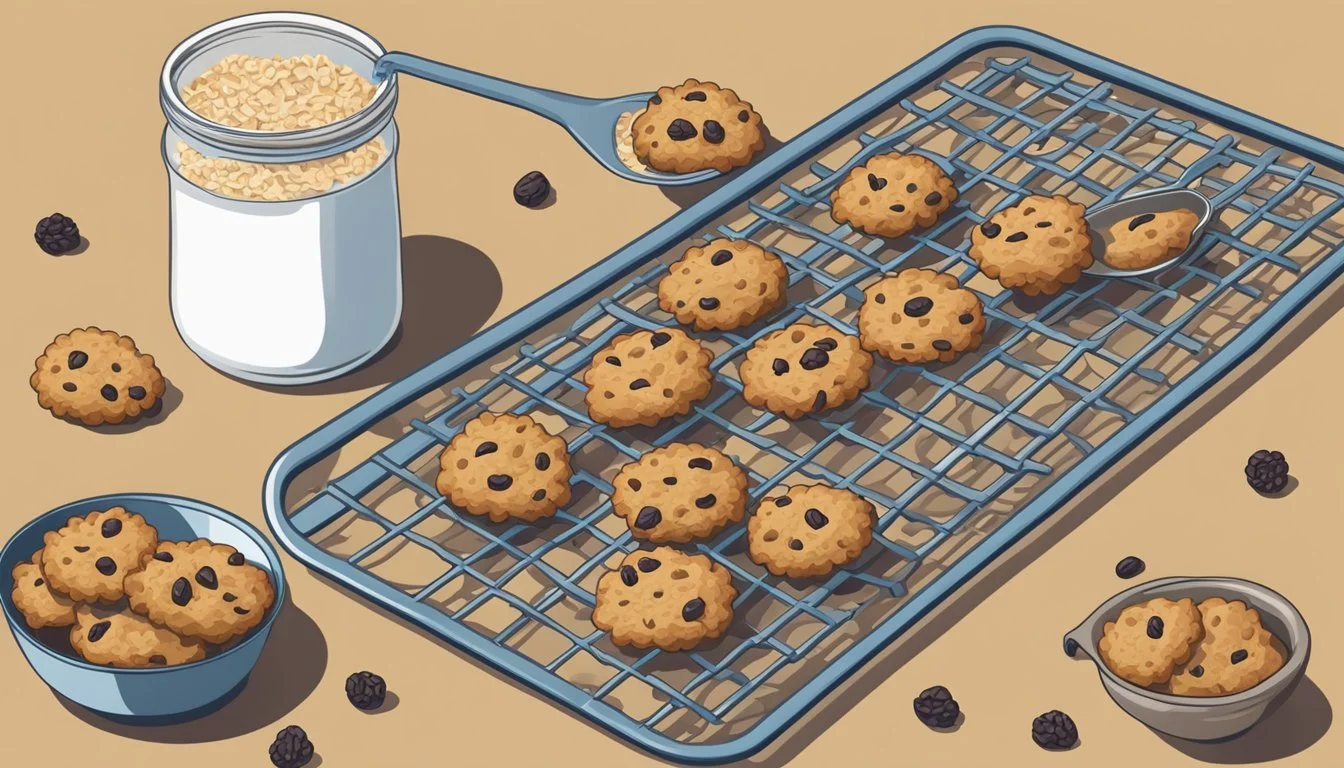How Do You Eat an Oatmeal Raisin Cookie?
Unveiling the Best Practices
Eating an oatmeal raisin cookie can be a comforting, delightful experience, particularly for those who savor the combination of sweet, chewy raisins with the hearty texture of oatmeal. These cookies have stood the test of time as a beloved treat in many households, and their appeal lies in both their flavor and texture. A well-made oatmeal raisin cookie offers a chewy bite, often achieved through the precise combination of ingredients and the specific way the cookies are baked.
The process of making oatmeal raisin cookies involves creaming together butter and sugars, adding eggs for richness, and vanilla for flavor, followed by the dry ingredients which include the oats, flour, and a leavening agent that ensures the cookies rise slightly. Every recipe amounts to a careful balance of these elements to ensure the final product has that signature chewy texture complemented by the sweet morsels of raisins throughout. The cookies are then typically baked until they are just set and soft in the middle to maintain their moisture.
When it’s time to eat an oatmeal raisin cookie, preferences may vary. Some might enjoy them warm from the oven when they are particularly soft and the flavors are at their most pronounced. Others might prefer to let them cool to room temperature for a firmer texture that holds up better to dunking in a glass of milk or cup of coffee. Regardless of personal taste, a well-executed oatmeal raisin cookie is a treat that satisfies with each chewy bite and a harmony of flavors that has a unique ability to evoke nostalgia.
Selecting Quality Ingredients
The foundation of a delicious oatmeal raisin cookie lies in the quality of ingredients one selects. The choice of oats, raisins, and flour directly affects the flavor, texture, and overall quality of the cookies.
Choosing the Right Oats
When selecting oats, one must decide between quick oats and old-fashioned rolled oats. Quick oats provide a softer texture, as they are cut and rolled to reduce cooking time. For a chewier cookie with a robust texture, old-fashioned rolled oats are preferred, as they maintain their shape and offer a heartier bite.
Types of Raisins and Their Preparation
The raisins in an oatmeal raisin cookie contribute to the cookie's moisture and sweetness. Dark raisins typically offer a deep sweetness, while golden raisins tend to be slightly tangier. To enhance the flavor and texture, raisins can be plumped by soaking them in a liquid such as egg and vanilla mixture, as indicated by one of the search results. This process ensures the raisins distribute moisture throughout the cookie during baking.
Flour Varieties and Their Impact on Texture
The choice of flour is critical. All-purpose flour is often used for its versatility and ability to create a desirable texture in baked goods. Using only all-purpose flour yields a customary balance between a tender and firm cookie texture. For a denser, heartier cookie, one might consider integrating whole wheat flour alongside the all-purpose variety. The type and ratio of flour used can drastically alter a cookie's final texture.
Preparing the Cookie Dough
Creating the perfect oatmeal raisin cookie dough involves a meticulous process where precision leads to the desired texture and taste. The foundation of this lies in correctly creaming the butter with sugars, incorporating the dry ingredients thoroughly, and blending in eggs and vanilla extract for richness and flavor.
Creaming Butter and Sugars
One begins by taking room temperature butter and blending it with brown sugar. This process is crucial as it introduces air into the mixture, creating a light and fluffy base. This step usually takes about 3 minutes with a hand or stand mixer set to medium speed.
Ingredients:
Butter – room temperature
Brown Sugar
Instructions:
Place butter and brown sugar in a large bowl.
Use a mixer to cream the ingredients until the mixture is light and fluffy.
Integrating Dry Ingredients
Next, the dry ingredients, which include all-purpose flour, baking soda, cinnamon, and salt, are sifted together to ensure even distribution. Then, this mixture is gradually added to the creamed butter and sugars. A spatula is often used to incorporate them, but not to overmix, as that could result in a dense cookie.
Dry Ingredients:
Flour – for structure
Baking Soda – for rise
Cinnamon – for flavor
Salt – for balance
Procedure:
Whisk the flour, baking soda, cinnamon, and salt together.
Stir the dry ingredients into the butter/sugar mixture until just combined.
Adding Eggs and Vanilla Extract
Finally, eggs and vanilla extract are added to the mixture. These ingredients are essential for binding the dough and adding a rich flavor, respectively. Each egg is mixed one at a time followed by the vanilla, ensuring they are fully integrated into the dough.
Wet Ingredients:
Eggs – for binding
Vanilla Extract – for flavor
Method:
Beat in eggs one at a time into the dough mixture.
Mix in vanilla extract until the cookie dough is uniform in consistency.
Once these steps are completed, one achieves a supple and well-seasoned cookie dough ready for the final additions of oats and raisins before baking.
Baking Techniques
When baking oatmeal raisin cookies, one must pay attention to accurate oven settings, proper cookie shaping, and precise bake times to ensure the perfect texture and flavor.
Oven Settings and Preheating
It is imperative to preheat the oven properly before baking the cookies. Most recipes require an oven to be heated to around 350ºF (177ºC). A properly preheated oven ensures even baking and helps achieve a desirable texture in the cookies. Use an oven thermometer to confirm the temperature, as some ovens can be off by a considerable margin.
Portioning and Shaping the Cookies
Consistency in cookie size and shape contributes to an even baking process. One can use a scoop or a tablespoon to measure out the dough, which then should be rolled into balls or dropped onto a lined baking sheet with parchment paper to prevent sticking. Ensuring even spacing between the cookies is crucial as it allows for proper heat circulation and prevents the cookies from merging into each other.
Determining the Right Bake Time
The bake time significantly affects whether the cookies turn out soft or crisp. A typical bake time ranges from 10 to 12 minutes, but it is essential to start checking the cookies around the 8-minute mark. Cookies should be golden brown around the edges but still soft in the center, knowing they will continue to cook slightly after being removed from the oven. For a crisper texture, one might extend the bake time by a few minutes. A toothpick or a cake tester can be used to check the doneness of larger cookies.
Perfecting Cookie Texture
Achieving the ideal texture in oatmeal raisin cookies is a matter of balancing ingredients and baking techniques. Subtle variations can produce markedly different textures, from chewy interiors to crisp edges.
Achieving the Ideal Chewiness
The key to creating chewy cookies relies in part on the use of high-protein flour such as bread flour, which can create a denser, chewier texture when compared to all-purpose flour. The ratio of brown sugar to white sugar also plays a significant role; brown sugar, with its higher moisture content, lends a more chewy quality to the finished cookie.
Flour Type: Bread flour > All-purpose flour for chewiness
Sugar Ratio: Higher brown sugar content promotes chewiness
Creating Crisp Edges
Contrasting with the soft, chewy center, crisp edges offer a delightful texture variation. To achieve this, one can slightly increase the amount of butter or bake the cookies at a higher temperature for a shorter period of time. It’s also advisable to space dough balls on the cookie sheet to allow heat to circulate and create those crispier edges.
Butter Amount: More butter for crispier edges
Oven Temperature: Higher temperature shortens baking time but increases edge crispness
Factors Influencing Softness
Several factors contribute to a cookie's softness. Using an ingredient like oatmeal inherently lends moisture to the cookie, contributing to a softer texture. How long they are baked and at what temperature matters as well; underbaking slightly can ensure softer cookies, while storing them in an airtight container will preserve their moisture and softness post-baking.
Oatmeal: Naturally adds moisture for softness
Baking Time: Less time = softer cookies
Storage: Airtight containers keep cookies soft
Storage and Enjoyment
Proper storage methods ensure that oatmeal raisin cookies maintain their soft and chewy texture, providing that comfort of a freshly baked treat. Serving suggestions can transform the simple act of eating a cookie into a delightful experience.
Storing Cookies for Freshness
To keep oatmeal raisin cookies fresh, they should be stored in an airtight container at room temperature. This can maintain their softness for up to 7 days. For longer storage, one may freeze the cookies for up to 3 months, making sure they are wrapped tightly in plastic wrap followed by a layer of aluminum foil or placed inside a freezer-safe airtight container.
Serving Suggestions
Cookies should be served at room temperature for optimal taste and texture. If they have been refrigerated or frozen, letting them sit out for around 20 minutes before serving will enhance their flavor and restore the desired softness. Oatmeal raisin cookies can also be warmed in a microwave for a few seconds if a warm cookie is preferred.
Pairings and Accompaniments
A pairing that complements oatmeal raisin cookies is a glass of cold milk, which adds a refreshing contrast to the dense, sweet flavors of the cookie. Here are ideal accompaniments:
Hot Beverages: Tea, coffee, or a warm cup of milk can be relaxing companions to the cookie.
Ice Cream: A scoop of vanilla ice cream alongside a cookie makes for a rich dessert option.
Yogurt: For a lighter accompaniment, a dollop of plain or flavored yogurt pairs pleasantly.
Using these guidelines, one can store oatmeal raisin cookies effectively for lasting freshness and enjoy them with perfect pairings for a comforting and satisfying snack or dessert.
Alternative Variations
Exploring alternative variations of oatmeal raisin cookies can satisfy different taste preferences and dietary needs. From the addition of chocolate chips to creating gluten-free and vegan options, one can tailor their cookie experience.
Oatmeal Chocolate Chip Cookies
Replacing raisins with chocolate chips offers a delightful twist to the traditional oatmeal cookie. The semi-sweet morsels complement the cookie's texture and add a rich, chocolatey flavor that pairs well with the oatmeal base.
Ingredients Variations:
Classic: Substitute raisins with equal parts chocolate chips.
Double Chocolate: Add cocoa powder to the dough for a deeper chocolate taste.
Incorporating Nuts and Other Dried Fruits
Adding nuts introduces a satisfying crunch and a boost of nutrition to the cookies. One can also mix in different dried fruits (What wine goes well with dried fruits?) to create unique flavor profiles.
Suggested Combinations:
Walnuts or pecans with dried cranberries.
Sliced almonds with chopped dates.
Cashews with dried cherries.
Gluten-Free and Vegan Options
For those with dietary restrictions, oatmeal cookies can be modified to be gluten-free by using gluten-free oats and flour blends. Vegan substitutions include using plant-based butter and flax eggs.
Substitutions:
Butter: Plant-based butter or coconut oil.
Eggs: Flax or chia eggs (1 tablespoon flaxseed meal + 3 tablespoons water = 1 egg).
Flour: Gluten-free oat flour or a gluten-free all-purpose flour mix.






